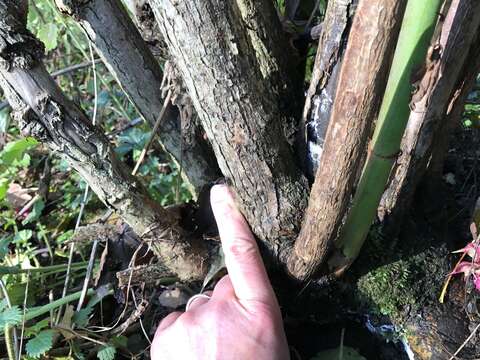Leycesteria formosa mature trunk with finger for scale

Description :
Summary.mw-parser-output table.commons-file-information-table,.mw-parser-output.fileinfotpl-type-information{border:1px solid #a2a9b1;background-color:#f8f9fa;padding:5px;font-size:95%;border-spacing:2px;box-sizing:border-box;margin:0;width:100%}.mw-parser-output table.commons-file-information-table>tbody>tr,.mw-parser-output.fileinfotpl-type-information>tbody>tr{vertical-align:top}.mw-parser-output table.commons-file-information-table>tbody>tr>td,.mw-parser-output table.commons-file-information-table>tbody>tr>th,.mw-parser-output.fileinfotpl-type-information>tbody>tr>td,.mw-parser-output.fileinfotpl-type-information>tbody>tr>th{padding:4px}.mw-parser-output.fileinfo-paramfield{background:#ccf;text-align:right;padding-right:0.4em;width:15%;font-weight:bold}.mw-parser-output.commons-file-information-table+table.commons-file-information-table,.mw-parser-output.commons-file-information-table+div.commons-file-information-table>table{border-top:0;padding-top:0;margin-top:-8px}@media only screen and (max-width:719px){.mw-parser-output table.commons-file-information-table,.mw-parser-output.commons-file-information-table.fileinfotpl-type-information{border-spacing:0;padding:0;word-break:break-word;width:100%!important}.mw-parser-output.commons-file-information-table>tbody,.mw-parser-output.fileinfotpl-type-information>tbody{display:block}.mw-parser-output.commons-file-information-table>tbody>tr>td,.mw-parser-output.commons-file-information-table>tbody>tr>th,.mw-parser-output.fileinfotpl-type-information>tbody>tr>td,.mw-parser-output.fileinfotpl-type-information>tbody>tr>th{padding:0.2em 0.4em;text-align:left;text-align:start}.mw-parser-output.commons-file-information-table>tbody>tr,.mw-parser-output.fileinfotpl-type-information>tbody>tr{display:flex;flex-direction:column}.mw-parser-output.commons-file-information-table+table.commons-file-information-table,.mw-parser-output.commons-file-information-table+div.commons-file-information-table>table{margin-top:-1px}.mw-parser-output.fileinfo-paramfield{box-sizing:border-box;flex:1 0 100%;width:100%}} Description: English: Base of a large (circa 2m) mature specimen of Leycesteria formosa with human finger laid beside thickest trunk to show scale. Note solitary, young, green stem among the mature trunks clad in grey bark. Plant growing on south-facing wall of the walled garden (exterior of wall - not inside garden) at Berrington, Northumberland. Probably grew originally from droppings of a bird which had fed on the berries of another specimen inside the garden - typical mode of seed-distribution for this species. This shrub is a popular garden plant in the UK, grown for its pendent strings of pale flowers subtended by deep pink bracts. It was introduced from its native Himalayas as an ornamental and as food for pheasants - hence the main English common name "pheasant berry" - raised as game birds who relish the ripe fruits. When fully ripe, the fruits are also edible by humans, having a mild caramel/chocolate flavour, although they are bitter and acrid when unripe. The plant is used in Traditional Chinese Medicine and the hollow stems have been used in India to make whistles and flutes. Date: 1 November 2021. Source: Own work. Author: Flobbadob.
Inclus dans les pages suivantes :
- Life
- Cellular (Organismes cellulaires)
- Eukaryota (eucaryotes)
- Archaeplastida
- Chloroplastida (plantes vertes)
- Streptophyta
- Embryophytes
- Tracheophyta
- Spermatophytes (plante à graines)
- Angiosperms
- Eudicots
- Superasterids
- Asterids
- Dipsacales
- Caprifoliaceae (Caprifoliacées)
- Leycesteria
- Leycesteria formosa
Cette image ne figure dans aucune collection.
Informations sur la provenance
- licence
- cc-by-sa-3.0
- droit d’auteur
- Flobbadob
- créateur
- Flobbadob
- original
- fichier de média d’origine
- visiter la source
- site partenaire
- Wikimedia Commons
- ID


